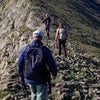Heading out the door? Read this article on the new Outside+ app available now on iOS devices for members! Download the app.
From vast forests to glittering glaciers, backpackers understand the importance of protecting our world more than most, which is why we’re making this story free to anyone who wants to trim their own personal carbon footprint. Find more stories about everything outdoors by signing up for Outside+. Members get access to all of Backpacker’s best stories, plus Outside’s other magazines like Climbing and Yoga Journal. Sign up for Outside+ today.
The typical American as an annual carbon footprint of 16 tons, which breaks down to a daily average of 96 pounds. Travel, household energy use, and purchased goods and services are the three main contributing factors to an individual’s carbon impact, accounting for 70 percent overall. When we’re out hiking, that usage drops significantly—yay, backpacking! But any kind of travel, even low-impact, contributes to a person’s carbon footprint.
In the following pages, we compare the impacts of five Americans embarking on a typical non-hiking vacation, a dream backpacking trip, and that same backpacking trip designed around minimizing environmental cost. Read on to see which hiker you identify with, and how you can plan your summer adventures around the lowest possible carbon expenditure.
The following stats were gathered by the climate experts at Backpacker’s carbon neutralizing partner, Cooler.
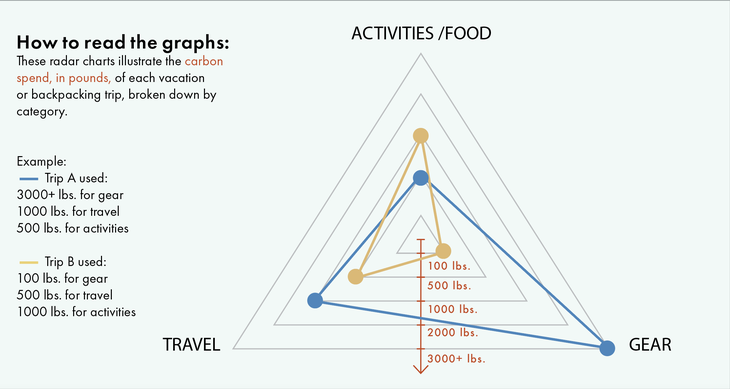
The Newbie
Tallahassee, FL
Lockdowns are something he’ll tell his grandkids about, but he’ll also tell those same grandkids about how he discovered a passion for the outdoors by way of being cooped up inside. Now, as states open up, he’s itching to turn those dayhikes into something more. But first, he’ll need to gather a full set of gear and will have to make some trip-length decisions.
For purposes of measurement, we’ll imagine that our newbie needs to acquire overnight gear and will take six four-day trips this year. The equivalent for a typical American will be six four-day trips built around golf and fishing.
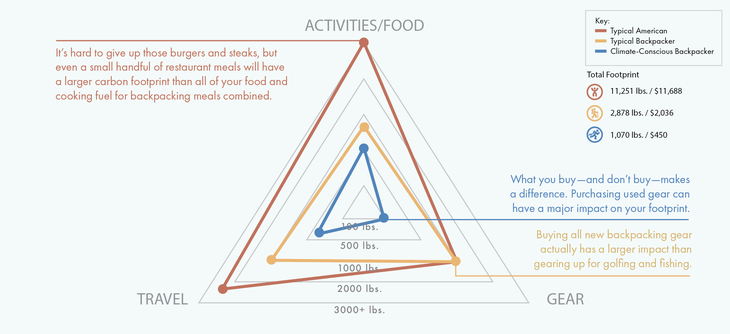
Typical American
This vacationer can’t get enough fishing and golfing, and he and his buddies get out every other month to Hilton Head, South Carolina (golf) or Panama City, Florida (fishing). On each trip, he spends two full days playing golf. He drives solo but shares a rental boat with two friends.
Travel: 2,306 lbs.
- 2,628 car miles
Activity/Food: 7,814 lbs.
- $8,772: 24 total days hotel and meals
- $660: 6 days golf fees
- $864: 2 days fishing (private charter split 3 ways)
- Total: $10,296
Gear: 1,131 lbs.
- $612: Golf clubs and balls
- $331: Golf shoes and clothes
- $449: Fishing rod and reel
- Total: $1,392
Typical Backpacker
There’s so much wilderness to explore right in his backyard. How about a section-hike of the Florida Trail starting in Apalachicola National Forest? He has hiking boots and adequate apparel but needs overnight gear and buys it all new. Driving mileage for each trip will increase as he gets more of the FT done.
Travel: 948 lbs.
- 1,080 car miles
Activity/Food: 760 lbs.
- $224: 24 days backpacking
- $258: Restaurant meals
- Total: $482
Gear: 1,170 lbs.
- $189: Tent
- $159: Backpack
- $100: Water filter
- $90 Stove and cookware
- $149: Sleeping bag
- $89: Sleeping pad
- $450: GPS
- $29: First aid kit
- $199: Waterproof jacket
- $100: Accessories
- Total: $1,554
Climate-Conscious Backpacker
This hiker wants to save money and the planet, so he buys mostly used gear (and rents some), skips restaurant stops, and stays in Apalachicola because there’s so much to explore right there. He also foregoes a GPS, since he is sticking to easy trails for now, and chooses iodine tablets over a water filter.
Travel: 404 lbs.
- 461 car miles
Activity/Food: 550 lbs.
- $224: 24 days backpacking
Gear: 116 lbs.
- $38: Tent
- $32: Backpack
- $11: Water tablets
- $18: Stove and cookware
- $30: Sleeping bag
- $18: Sleeping pad
- $29: First aid kit
- $50: Accessories
- Total: $226
The Life-Lister
Chicago, IL
She’s been dreaming of travel for months and now, it’s finally time. With a vaccination card in her wallet—along with some extra cash from over a year of saving—she’s ready to book that dream backpacking trip. Her kit is mostly dialed, but for a two-week adventure, she’ll need to pick up some extra gear. Escaping the city is a must.
For purposes of measurement, we’re sending our Life-Lister to Denali National Park for 10 days. The equivalent for a typical American is a week of house boating on Lake Powell, followed by three days in Vegas.
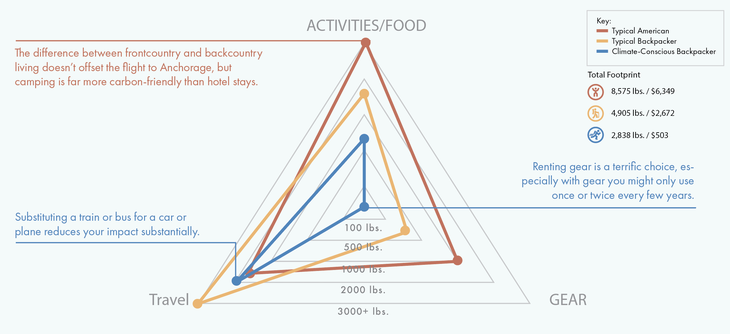
Typical American
After being cooped up for a year, this hard-working banker wants some sun, so she’s going to Lake Powell with a friend. They’ll fly from Chicago to Vegas, drive to Wahweap, then head back to Vegas after a week of boating for a three-day birthday and post-lockdown celebration.
Travel: 1,816 lbs.
- 3,600 air miles
- 662 car miles
Activity/Food: 5,663 lbs.
- $2,214: 3 days Las Vegas
- $1,925: 7 days house boat rental (split two ways)
- $613: 7 days boat fuel
- $350: 7 days food and drink
- Total: $5,102
Gear: 1,096 lbs.
- $645: SUP and paddle
- $153: Swim suit and toys
- $449: Fishing rod and reel
- Total: 1,247 lbs.
Typical Backpacker
Vegas? No way. She’s going big with a 10-day trip to Alaska. She’ll fly to Anchorage, drive to Denali, and grab a hotel before taking the park bus to the trailhead. After the trip, she’ll spend another night outside Denali, then drive up to Fairbanks for a night to look for the northern lights before returning to Anchorage for the flight home.
Travel: 3,092 lbs.
- 6,000 air miles
- 716 car miles
- 60 bus miles
- $890: Rental SUV
Activity/Food: 1,398 lbs.
- $215: 7 days backpacking
- $376: 1 day Denali (outside park)
- $514: 1 day Fairbanks
- $276: 1 day Anchorage
- Total: $1,381
Gear: 415 lbs.
- $99: Bear canister
- $40: Bear spray
- $299: Better raingear
- $33: maps
- Total: $401
Climate-Conscious Backpacker
To maximize her hiking time and minimize her carbon footprint, our explorer skips the rental car in favor of taking Amtrak to Denali, where she camps for one night instead of booking a hotel. She spends her whole time hiking, and splurges on a fresh salmon dinner back in Anchorage before flying out. She rents a bear canister and borrows raingear from a friend.
Travel: 2,176 lbs.
- 6,000 air miles
- 716 train miles
- 60 bus miles
- $171: Train ticket
Activity/Food: 622 lbs.
- $243: 10 days backpacking (camp food and gas; permits required)
- $33: 1 restaurant meal
- Total: $276
Gear: 40 lbs.
- $23: Bear canister (rent instead of buy)
- $0: Better raingear
- $33: Maps
- Total: $56
The Road Trippers
Denver, CO
This adventurous family of four wants to visit national parks this summer in their camper van. They’re dreaming of Yellowstone and Grand Teton, with a mix of car camping and backpacking. They are already pretty geared-up and self-sufficient.
For purposes of measurement, we’ll assume that our fun family is doing a 10-day trip. The equivalent for our typical American family vacation will be 5 days at Disney World, followed by 5 days of water skiing at a resort in North Carolina. All figures are for four people.
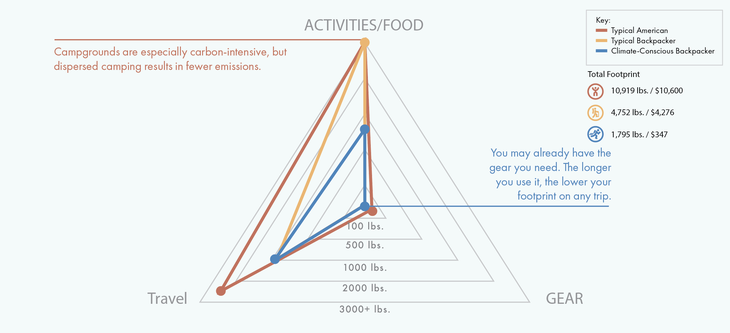
Typical American
The kids have been begging for Disney World, and old friends have invited the family for a holiday in the Southeast. Everyone’s dreams come true with a flight to Atlanta, followed by road tripping from Orlando to North Carolina.
Travel: 2,697 lbs.
- 10,400 air miles
- 1,800 car miles
Activity/Food: 8,222 lbs.
- $4,200: 5 days Disney World
- $5,000: 5 days North Carolina (resort cost)
- $1,400: 3 days water skiing
- Total: $10,600
Gear: 0 lbs.
- $0: None
Typical Backpacker
Their itinerary includes four nights of backpacking, four nights of campgrounds, and two nights of hotels on their loop through Yellowstone and Grand Teton. They splurge on some restaurant meals along the way, as well as rafting and fly-fishing.
Travel: 943 lbs.
- 1,075 car miles
Activity/Food: 3,809 lbs.
- $197: 4 days backpacking
- $123: 2 days hiking
- $224: 4 nights campground fees
- $240: 4 restaurant lunches (Burgers and shakes)
- $448: 4 restaurant dinners (Post-trip steak and beers)
- $1,420: 1 day/night Jackson Hole
- $424: 1 day/night West Yellowstone
- $600: 1 rafting trip
- $600: 1 guided fly-fishing trip
- Total: $4,27
Gear: 0 lbs.
- $0: None
Climate-Conscious Backpacker
To reduce cost and impact, this family makes a couple key moves: They skip the guided adventures, use the camper van they already own to maximum advantage to avoid hotels and restaurants, and, well, they go backpacking. A lot!
Travel: 943 lbs.
- 1,075 car miles
Activity/Food: 852 lbs.
- $347: 8 days backpacking (food and gas; permit required)
- $0: 3 nights free camping (dispersed campsites)
Gear: 0 lbs.
- $0: None
The Thru-Hiker
San Francisco, CA
She couldn’t use her vacation time last year, so this young tech-industry hiker plans to use three of her four accrued weeks to hike the John Muir Trail at a nice, leisurely pace. As a runner, she’s superfit, but like our Newbie she needs to get geared up. She’s traveling with a friend who shares her passions.
The equivalent to a JMT thru-hike for a typical American will be a wine-tasting tour of Napa and Sonoma followed by a week of hiking around the Oregon coast.
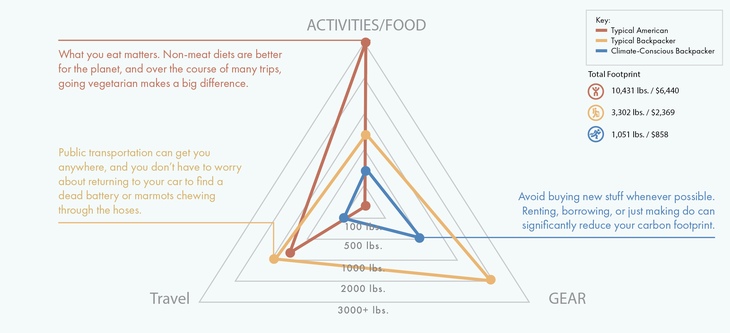
Typical American
In addition to PTO, this traveler has saved a fair bit of money, so there’s no need to skimp on lodging, food, or drink. She and her partner will carpool and stay in Airbnbs along the way.
Travel: 831 lbs.
- 947 car miles (split two ways)
Activity/Food: 4,800 lbs.
- $2,215: 5 days Napa
- $1,680: 5 days Sonoma
- $1,645: 5 days Portland
- $900: 6 days various locations
- Total: $6,440
Gear: 0 lbs.
- $0: None
Typical Backpacker
She hates buses, so she and her partner both drive and leave a shuttle-car at Lone Pine. Since they’re taking three weeks to hike the JMT, they’ll go the luxe route with gear and food. What’s more weight when the daily mileage will be less than she typically runs before work every morning?
Travel: 945 lbs.
- 1,077 car miles (split two ways)
Activity/Food: 668 lbs.
- $252: 20 days backpacking (camp food and gas; permit required)
- $30: 2 restaurant meals en route (burgers and shakes)
- $28: 1 restaurant meal on return
- $150: Hotel in Lone Pine
- Total: $460
Gear: 1,689 lbs.
- $299: Tent
- $229: Backpack
- $100: Water filter
- $120: Stove & cookware
- $219: Sleeping bag
- $120: Sleeping pad
- $450: GPS
- $29: First aid kit
- $199: Waterproof jacket
- $150: Accessories
- Total: $1,909
Climate-Conscious Backpacker
Stunned by last year’s wildfires, she wants to limit her impact wherever possible. They’ll go minimalist with gear and travel. She’ll buy less (and lighter) stuff, which will make the miles easier, and they’ll train, bus, and hitchhike to avoid the need for either car. They’ll go 100 percent vegan, too, which cuts her food footprint by 40 percent.
Travel: 141 lbs.
- $64: Amtrak to Yosemite
- $0: Hitchhike to Lone Pine
- $18: Mammoth to Y Valley via YARTS
Activity/Food: 422 lbs.
- $172: 20 days backpacking (camp food and gas, permit required)
Gear: 488 lbs.
- $60: Used tent
- $46: Backpack
- $11: Water tablets
- $24: Stove & cookware
- $149: Sleeping bag
- $89: Sleeping pad
- $149: Waterproof jacket
- $79: Accessories
- Total: $604
The World Traveler
Brooklyn, NY
Europe is reopening, and he is eager to sample some culture. He’s already explored Florence and would like to see Milan, though he’s torn between a mountain adventure and a museum tour. Where he decides to go will be influenced by the newfound climate awareness he’s picked up over the last year. He’s leaning toward a 15-day hike linking trails and huts in the Swiss Alps.
For purposes of measurement, we’ll posit a 15-day journey for which our traveler needs no new gear. The equivalent typical American vacation is a museum and culinary tour of northern Italy.
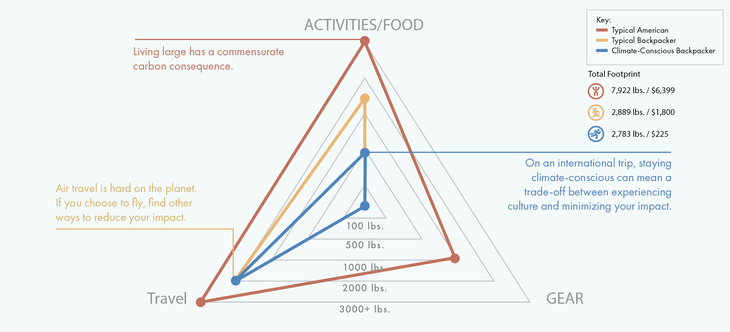
Typical American
Starting in Milan, he packs in museums, vineyards, and fabulous meals on a five-city, 15-day road trip around northern Italy.
Travel: 3,452 lbs.
- 8,000 air miles
- 1,500 car miles
Activity / Food: 3,578
- $3,000: Hotels
- $1,200: Restaurant meals
- $600: Entertainment
- Total: $4,800
Gear: 802 lbs.
- $1,599: New camera and lenses
Typical Backpacker
He read about the Via Alpina in Backpacker and wants to hike the entire 380 kilometers. To do that in the time he has, he’ll need to sleep in huts and inns and buy most of his meals to cut his pack weight. He’ll have to move fast, but the trip will be a full immersion experience with lots of local interactions. He’ll fly into Zurich and use Switzerland’s train system to get to and from the end points.
Travel: 2,230 lbs.
- 8,000 air miles
- 205 train miles
Activity / Food: 1,659 lbs.
- $675: 15 days backpacking (meals, no permits required)
- $1,125: Huts/inns
- Total: $1,800
Gear: 0 lbs.
- $0: None
Climate-Conscious Backpacker
Experiencing the Alps at their wildest will also help him reduce his footprint by avoiding inns and restaurant meals. Instead, he’ll bivouac in high mountain meadows—the Swiss call it “wild camping,” and it allows backpackers to pitch a tent almost anywhere, including private property, so long as you’re above treeline and outside specially protected zones.
Travel: 2,230 lbs.
- 8,000 air miles
- 205 train miles
Activity/Food: 553 lbs.
- $225: 15 days backpacking (groceries; no permits required)
Gear: 0 lbs.
- $0: None
From July/August 2021
